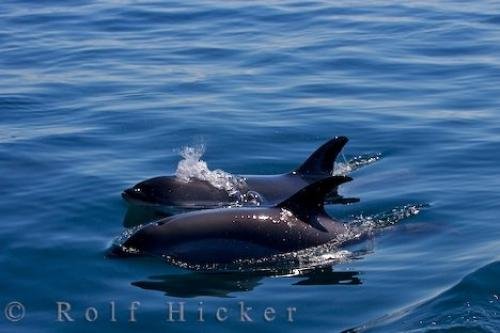Photo: Atlantic White Sided Dolphins Bay Of Fundy Nova Scotia
Two Atlantic White Sided Dolphins swim playfully alongside a tour boat during a sunny day in the Bay of Fundy, Nova Scotia. These dolphins are found in cool waters in the North Atlantic Ocean.
Atlantic white sided dolphins are actually slightly bigger than other ocean dolphins and can grow up to 2.8 metres long in adult males. They got their name from the pale yellow / white area that is just behind their dorsal fin on either side of their bodies. There is also another white patch on their bodies below the dorsal fin, just before their skin turns a light grey colour that runs from their beak down to their tail. These dolphins are considered a 'coloured' species, as they do actually contain many different colours on their bodies; various shades of greys, whites, and yellows.
There is estimated to be about 200,000 to 300,000 of these species in the wild now, and they tend to travel in groups of about 60 or so. They are found to be mostly found between the coast of Newfoundland, Canada and Cape Cod, USA. They were hunted in the past for their meat and blubber, mostly off the coast of Norway and Newfoundland. ... continue below the picture...
Atlantic White Sided Dolphins Bay Of Fundy Nova Scotia

Pictures from photo gallery "Yellow Eyed Penguin Pictures"
This picture is part of the photo album "Animal Pictures" - there are more beautiful images waiting for you.
Related stock photo galleries, pictures & travel ideas:
Atlantic White Sided Dolphins Bay Of Fundy Nova Scotia
... These hunting drives have since ended, but they are still in some danger of being caught in nets or accidentally caught in whaling expeditions.
When people go on whale watching expeditions, they can sometimes be privileged enough to see these dolphins as they are generally friendly and curious marine mammals and they will swim alongside the boats when they spot them. These two are curious enough to come right up to the tour boat during an excursion in the Bay of Fundy, Nova Scotia.
Atlantic White Sided Dolphins, Bay of Fundy, Nova Scotia, Canada.
Technical Information:
I photographed this photo with the digital SLR camera model Canon EOS-1Ds Mark II, aperture of f/8.0, exposure time of 1/500 sec. on ISO 100, as always I used a original Canon Lens, the focus lenght for this picture was 100mm.
Two Atlantic White Sided Dolphins swim playfully alongside a tour boat during a sunny day in the Bay of Fundy, Nova Scotia. These dolphins are found in cool waters in the North Atlantic Ocean.
